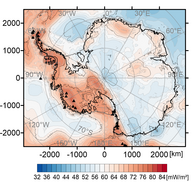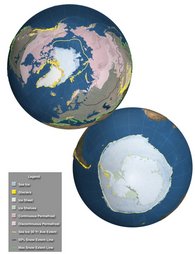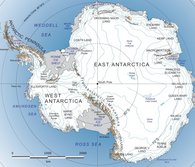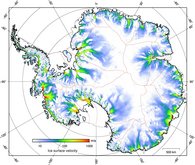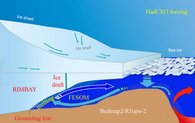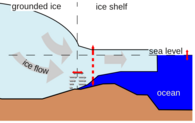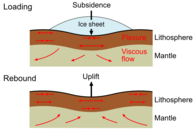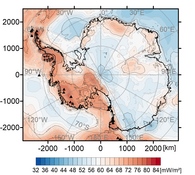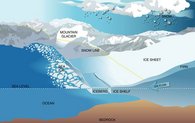Ice sheet dynamics
We use observations and numerical simulations to understand the dynamics of the large ice sheets of Greenland and Antarctica in the past and predict their dynamics in the future. A particular focus is on the mass balance of these ice sheets, since it has a direct impact on the global sea level. Interactions of the ice sheets with the ocean, the atmosphere and the solid earth play a key role in understanding their dynamics and for meaningful modeling.
The cryosphere is an important part of the global climate system and comprises those portions of the Earth’s surface where water is in its solid form, frozen into ice or snow. Elements of the cryosphere are found at all latitudes and encompass glaciers, ice caps and ice sheets as well as lake and river ice, sea ice, snow cover and frozen ground. The cryosphere is linked to its environment by many processes. It influences moisture fluxes, precipitation, hydrology, atmospheric and oceanic circulation. In particular, the high albedo of snow-covered areas has a large impact on the radiation balance. A change in extent of these areas directly affects the surface temperature of the Earth. Moreover, the components of the cryosphere store large amounts of water whereas nowadays about 99% of the global ice volume is concentrated in the ice sheets of the polar regions, in Greenland and in Antarctica. They have the potential to alter the global sea level by several meters under the influence of climate changes within the next centuries.
The Antarctic Ice Sheet (AIS) is situated on a continental land mass at the South Pole and spreads over almost 14 million square kilometers. It is subdivided into the Antarctic Peninsula and the West and East Antarctic Ice Sheets which are separated by the Transantarctic Mountains. Nearly half of the Antarctic coast line is covered by ice shelves, floating ice extensions of the AIS. The mean ice thickness of the AIS is 2160 meters while locally the ice thickness reaches a maximum of 4776 meters. The total ice volume has a sea level equivalent of about 58 meters. The evolution of the Antarctic ice volume is determined by its mass balance. Any imbalance of the dynamic equilibrium between mass gain and mass loss results in either a growth or a decrease of the ice body and thus a change of the global sea level.
The Antarctic ice sheet gains mass by surface snow accumulation which over time compacts to ice. The ice flow from the interior of the AIS towards its margins is caused by gravity and is the combined result of creep flow and basal sliding. The flow follows the ice sheet surface gradient and reaches surface velocities in the order of meters per year in the inner regions of the ice sheet. At the ice sheet margins, the ice flow is dominated by several fast flowing ice streams. They transport large amounts of ice at velocities of up to several hundred meters per year towards the coast or are feeding into adjacent ice shelves. There, the mass loss is dominated by two processes in approximately equal shares: First, mass is lost by calving of glaciers and ice shelves where ice breaks off and forms icebergs. Second, the floating ice shelves loose mass at their base by melting due to the ocean heat flux. In comparison, only a vanishing low portion is contributed by ice melting at the base of grounded ice and by surface melting (only at the Antarctic Peninsula).
SICOPOLIS (SImulation COde for POLythermal Ice Sheets) is a 3d dynamic/thermodynamic model that simulates the evolution of large ice sheets and ice caps. It has been developed continuously since 1997 and applied to problems of past, present and future glaciation of Greenland, Antarctica, the entire northern hemisphere, the polar ice caps of the planet Mars and others.
RIMBAY is a modular multi-approximation thermomechanical ice sheet / shelf model featuring shallow shelf and shallow ice approximations, hybrid shallow stress balance as well as higher order schemes for ice velocity calculation, full 3d grounding line migration schemes, subglacial hydrology, various ocean and atmosphere coupling interfaces. It can be used to simulate both small-scaled glaciers and continental ice sheets.
PISM (Parallel Ice Sheet Model) is open source and capable of high resolution. It has been widely adopted as a tool for doing science since 2011 and features extensible atmospheric/ocean coupling, hybrid shallow stress balance, marine ice sheet physics, polythermal energy conservation, subglacial hydrology and till model and parallel simulations using MPI and PETSc.
References:
Bernales, J., Rogozhina, I., Greve, R., Thomas, M. (2017): Comparison of hybrid schemes for the combination of Shallow Approximations in numerical simultions of the Antarctic Ice Sheet. - The Cryosphere, 11, pp. 247-265. doi.org/10.5194/tc-2016-117 GFZPublic
Ice sheet - ocean dynamics
Ice shelves are in direct contact with the ocean water at their lower surface. Consequently, the temperature and the circulation of the ocean water in the ice shelf cavity determine the basal ice melt rates. They affect the shelf ice thickness and thus the position of the groundling line, which has a great impact on the dynamics of the adjacent grounded ice sheet, its mass balance and thus the global sea level. On the other hand, the shape of the ice shelf cavity, the position of the grounding line and the amount of melted fresh water have a crucial impact on the circulation of the ocean water underneath the ice shelf.
Publications:
Timmermann, R. and Goeller, S. (2017): Response to Filchner-Ronne Ice Shelf cavity warming in a coupled ocean-ice model. Part I: The ocean perspective, Ocean Science 13: 765-776
Thomas, M., Determann, J.; Grosfeld, K. Hellmer, H. and Goeller, S. (2015): Future sea-level rise due to projected ocean warming beneath the Filchner Ronne Ice Shelf: A coupled model study, Earth and Planetary Science Letters, 431: 217-224.
Bernales, J., Rogozhina, I., Thomas, M. (2017): Melting and freezing under Antarctic ice shelves from a combination of ice-sheet modelling and observations. - Journal of Glaciology, 63, 240, pp. 731-744. doi.1017/jog.2017.42 GFZPublic
Ice sheet - sea level
Ice sheets store large amounts of fresh water. Thus, every change of their mass balance has an impact on the global sea level. If the sea level is, e.g., rising, so far grounded ice comes afloat and the grounding line migrates further inland. In general, the position of the grounding line, which separates grounded and floating ice, is a key parameter for ice dynamics. Consequently, the sea level is considered a global coupling parameter. For example, the melting on the northern hemisphere can cause a global seal level rise and can thus influences the dynamics of the Antarctic Ice Sheet on the southern hemisphere. In addition, every variation of the ice mass causes local earth surface deformations and gravity changes, resulting in a local sea level change and thus an impact on the ice dynamics at the grounding line.
Publications:
Klemann, V., Heim, B., Bauch, H. A., Wetterich, S. and Opel, S. (2015) Sea-level evolution of the Laptev Sea and the East Siberian Sea since the last glacial maximum, arktos, 1 (1): 1-8
Konrad, H., Sasgen, I., Klemann, V., Thomas, M., Grosfeld, K., Martinex, Z. (2016): Sensitivity of Grounding-Line Dynamics to Viscoelastic Deformation of the Solid-Earth in an Idealized Scenario. Polarforschung, 85, 2, pp. 89-99. DOI: doi.org/10.2312/polfor.2016.005 GFZPublic
Current projects:
Ice sheet - lithosphere I
The glacial isostatic adjustment (GIA) describes how the Earth responds to the load of an ice sheet. The adaption of the Earth's body to the redistribution of ice and water since the last glacial maximum is still going on. It is observed and analyzed to estimate the extent and mass of former ice loads, to reconstruct the global sea level over one glacial cycle as well as determine the rheological properties of the Earth.
Ice sheet - lithosphere II
The geothermal heat flux between solid earth and ice sheet base influences the temperature and thus the viscosity of the ice. At higher temperatures the ice has a lower viscosity. As a consequence, the ice deforms easier under the influence of gravity which results in higher ice flow velocities. At lower temperatures, the ice has a higher viscosity which makes it stiffer. Thus, less internal deformation takes place resulting in lower ice flow velocities. If the geothermal heat flux flow reaches a certain threshold, basal melting occurs at the base of the ice sheet. This melt water lubricates the ice base and thus the ice sheet can slide on its substrate. Underneath the Antarctic Ice Sheet, basal water forms thin water layers, rivers and large lakes and flows over huge distances. The existence of water at the ice sheet base increases the ice velocity as well, since its the sum of internal deformation and basal sliding.
Publications:
Goeller, S., Steinhage, D., Thomas, M. and Grosfeld, K. (2016): Assessing the subglacial lake coverage of Antarctica, Annals of Glaciology, 57(72): 109 - 117
Rogozhina, I., Petrunin, A. G., Vaughan, A. P. M., Steinberger, B., Johnson, J. V., Kaban, M. K., Calov, R., Rickers, F. Thomas, M., Koulakov, I. (2016): Melting at the base of the Greenland Ice Sheet explained by Iceland hotspot history. - Nature Geoscience, 9, pp. 366-369. DOI: doi.org/10.1038/ngeo2689 GFZPublic
Ice sheet - atmosphere
The albedo of a surface influences the radiation balance and thus the temperature at the surface. Clean and white snow (e.g., Antarctic Ice Sheet) has a high albedo, reflecting almost the entire incidental radiation. Black ice (e.g., Alpine glacier during summer) and dust covered ice (e.g., Greenland Ice Sheet at its margins) absorb much more of the incidental radiation, leading to a rise of temperature at the surface and as a possible consequence to surface melting. The temperature at the ice surface has an impact on the temperature of deeper ice layers as well. It affects the viscosity of the ice which determines the grade of internal deformation and thus the ice flow velocity. Moisture fluxes at the ice surface have an impact on the dynamics of the atmosphere. In turn, the dynamics of the atmosphere with its precipitation have a crucial impact on the mass balance of the ice sheet.


